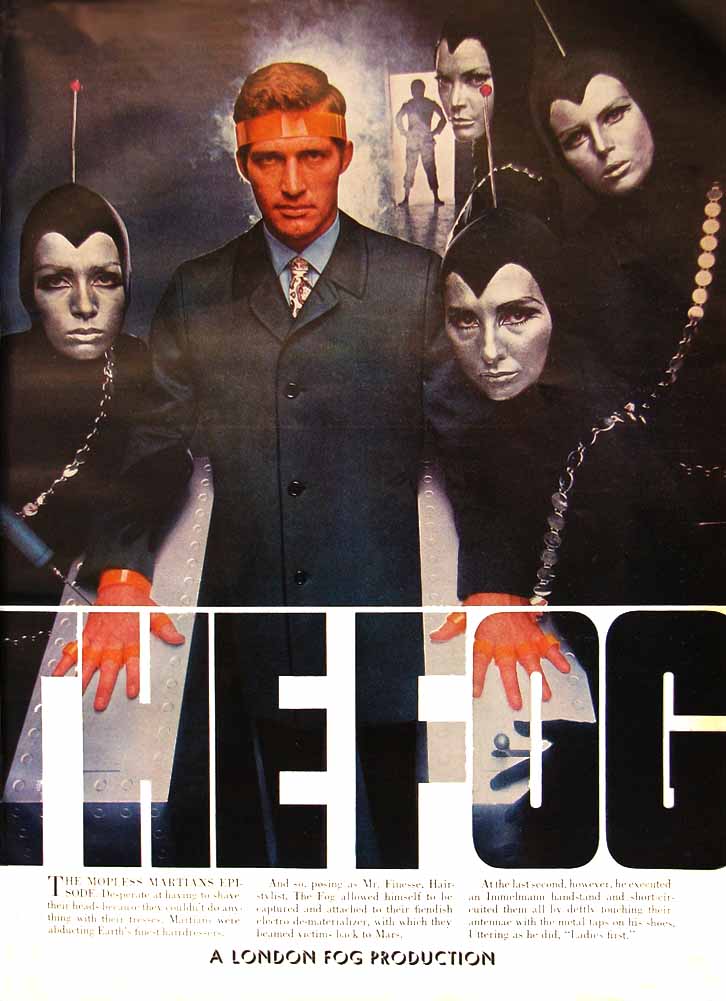| Vintage Pulp | Dec 1 2022 |

Stanwyck and MacMurray make a dangerous bet
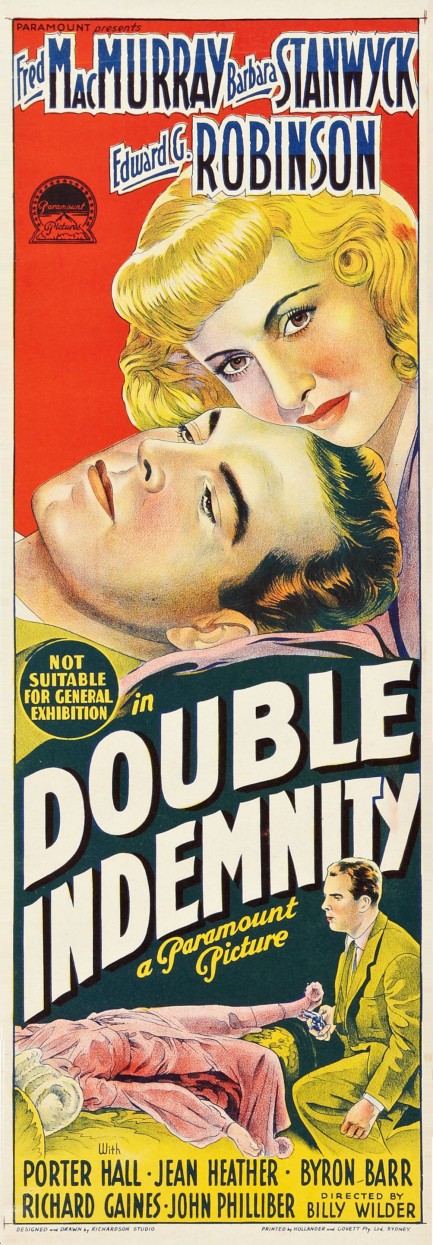
There are still, after all these years, important classic films we've never discussed in detail. We can now cross Double Indemnity off the list. The movie starred Barbara Stanwyck and Fred MacMurray, and we've looked at its West German poster, had fun with one of its promo images, and talked about its ingenious quasi-remake, but never actually gotten to the movie itself. Well, here we are, and now the question is can we tell you anything you don't already know? Possibly not, but let's start with the Australian daybill, which you see above. It isn't the usual poster you find online, so that's something, anyway.
The movie begins with MacMurray making a confession, then slides into flashback to explain his crime. He plays an insurance salesman for Pacific All Risk who quickly realizes that Stanwyck's interest in secretly purchasing a life insurance policy on her husband is for the purposes of murder and claimant fraud. He resists the scheme at first but Stanwyck convinces him. How? All we see are a few kisses but the answer has to be sex. McMurray is a guy who has experience with women and is so confident with them he's almost glib. He wouldn't agree to murder a guy just because someone is a good kisser.
Thus, temptation nudges him, unseen sex tips him over the edge, and from there he and Stanwyck are off and running with their murder plot. Eventually Stanwyck's husband is found dead on a train track, presumably after falling off the observation car of the Los Angeles-Santa Barbara express, and the crime seems perfect, except the insurance policy that will pay $100,000 brings a tenacious investigator into the picture. That would be Edward G. Robinson in another great performance, and he immediately latches onto an anomaly—Stanwyck's husband didn't file an insurance claim when he broke his leg weeks earlier. Why would a guy who had accident insurance not make a claim? Maybe he didn't know he had accident insurance.
Robinson's role and performance make the movie. He pulls on the single hanging thread that unravels the entire murder plot, and when it starts to come apart it does so almost too fast to believe. There's revelation upon revelation, even reaching years back to the time that Stanwyck's husband was married to another woman, and Stanwyck was that woman's nurse. It's this latter half that makes Double Indemnity a top classic—though make no mistake, it's a film noir clinic even from its first frames, in terms of visuals, structure, music, and direction from Billy Wilder. But when MacMurray's situation deteriorates so quickly and so uncontrollably in the last half, you almost experience the same vertigo and helplessness his character must feel.
Double Indemnity was nominated for seven Academy Awards, and as usual for the Oscars, was beaten in most of its categories by a film that ended up having far less influence—the Bing Crosby musical Going My Way. But time tells the tale. Nobody is calling Going My Way one of the best films ever made, but Double Indemnity was certainly a top ten film noir, and was influential far beyond its niche. The movie opened in the U.S. in the late spring of 1944 and finally reached Australia to dazzle and dismay audiences today, December 1, that same year.
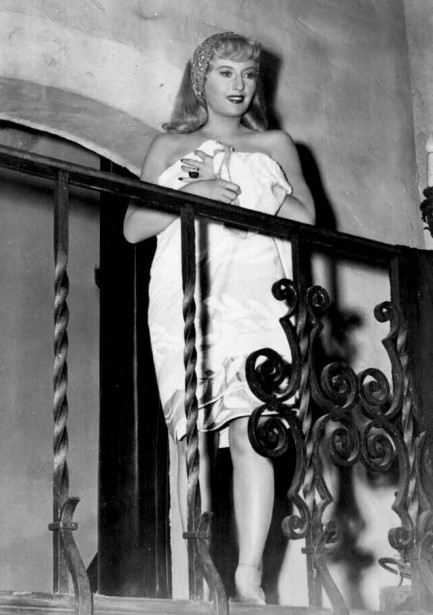
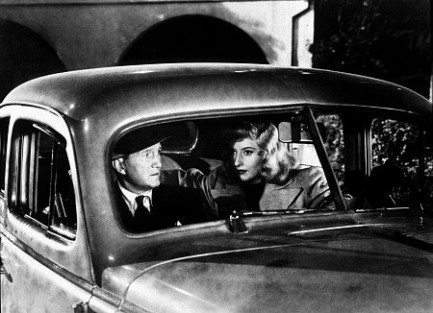
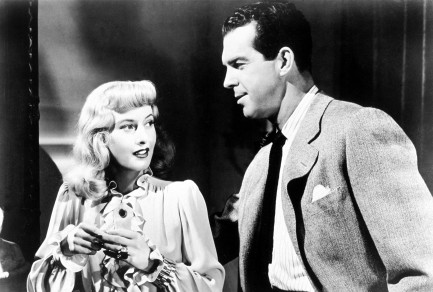
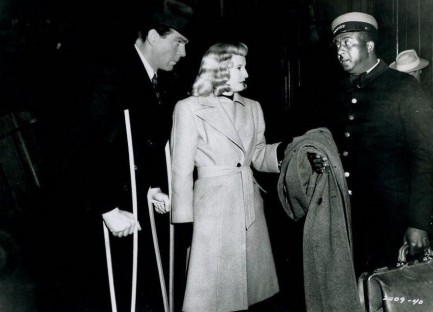
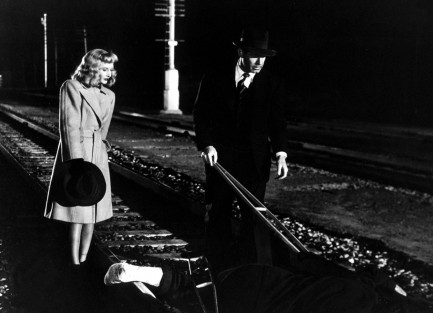
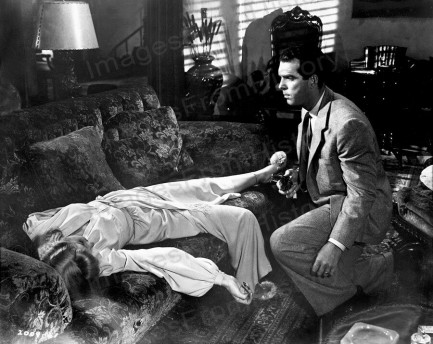
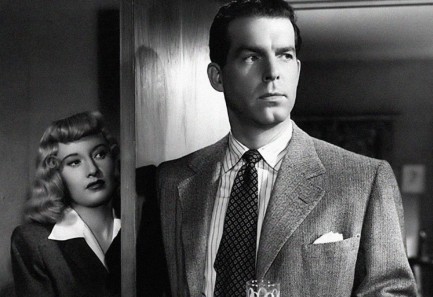
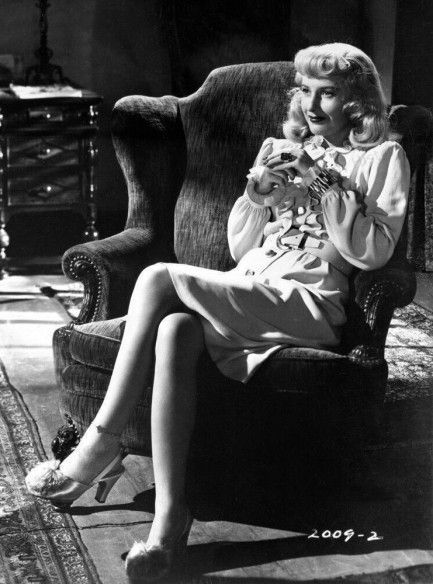
| Vintage Pulp | Oct 25 2022 |

Don't look. Don't move. Don't even breathe.
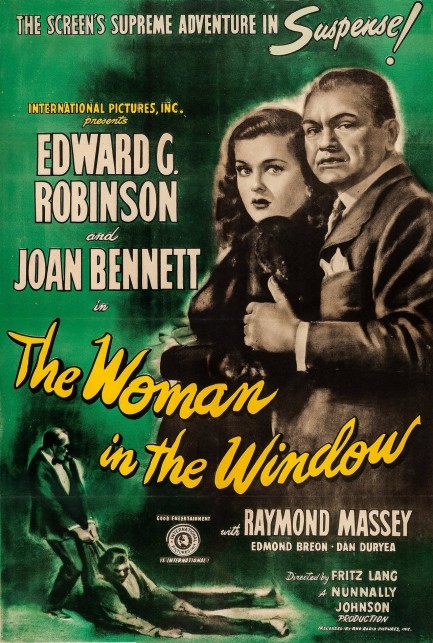
Here's a U.S. promo for Fritz Lang's film noir The Woman in the Window, which premiered today in 1944. The poster is unattributed, but it's fantastic work. There's normally a white border, but the version you always see online omits that. It's also highly saturated. We don't know if the color was the work of an industrious Photoshop user, but we do like it. However, a version that shows its real age—slightly less vibrant but still very nice—appears below. There are other differences too, such as the color of the figures and some of the lettering.
The Woman in the Window was headlined by star supreme Edward G. Robinson, who we love more with each movie we see. In this one he plays an everyman who gets into a nightmare situation over his head. That would be five feet, five inches for Robinson because he was such a diminutive guy, but the tallest man in the world would still be in deep trouble. You have to watch the movie to find out why, but you can read a little more about it and see a Swedish poster here, and a French poster here.


| Vintage Pulp | Jun 6 2022 |

Murder most premeditated.
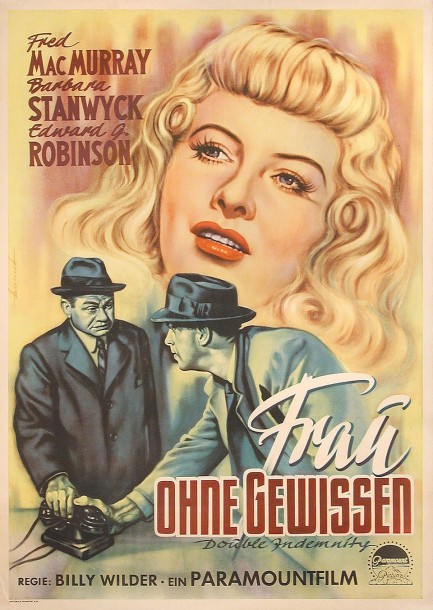
Above is a poster painted by German artist Heinz Bonne for the U.S. film noir classic Double Indemnity, starring Barbara Stanwyck and Fred MacMurray as lovers who try to pull off a murder and daring insurance fraud but may not be quite as smart or lucky as needed. We'll hopefully get back to Bonne a little later. Double Indemnity premiered in the U.S. in 1944, but made it to Germany—West Germany actually—as Frau ohne Gewissen, or “woman without a conscience,” six years later, today in 1950.
| Vintage Pulp | Jun 21 2021 |

He's a dead man walking but he's got big plans.
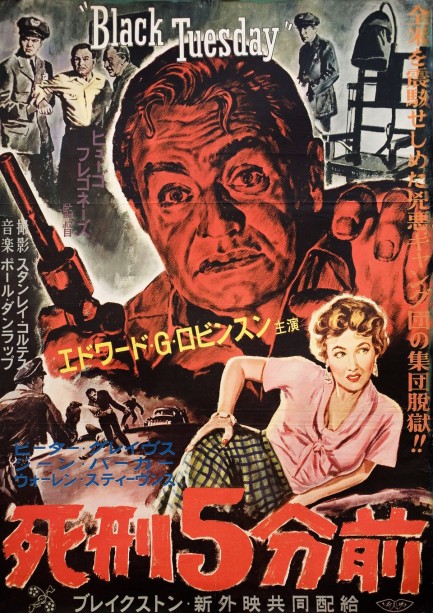
Above, a super Japanese poster for Black Tuesday, the Edward G. Robinson death row escape drama we discussed a couple of weeks ago. The distributors renamed it 死刑5分前, which means, “5 minutes before the death penalty.” The movie opened in Japan today in 1955, and you can read more about it here.
| Vintage Pulp | Jun 10 2021 |

Eddie G. never goes down without a fight.

Mid-century Belgian promo art strikes again. This is an epic poster. It was made for the crime drama Black Tuesday, which played in Belgium as Mardi ça saignera (French title) and Dinsdag zal er bloed stromen (Dutch title). Edward G. Robinson and Peter Graves star in the tale of two death row inmates who escape prison and go on the lam. Graves has hidden $200,000 from a bank robbery and Robinson plans to betray him and steal the dough. Unfortunately, Graves is critically shot during the escape and, even as he lies near death, refuses to say where the money is hidden.
This is a pretty nice flick. Virtually any movie with Robinson is worth a viewing. He played many types of characters in his career, but he's known for portraying tough guys, and this is classic Edward G., with all the snarls and sneers fans had come to expect from romps like Little Caesar and Key Largo. And why wouldn't he snarl? Unless a doctor he's taken hostage can save the day the cash he lusts for will never be found. But maybe Graves won't die. Maybe he's tougher than he seems—and smarter too. Robinson never wins in his gangster roles, so it's a question of how he'll lose, not if. But it's always fun watching him fight the bad fight. Black Tuesday premiered in the U.S. in late 1954 and reached Belgium today in 1955.
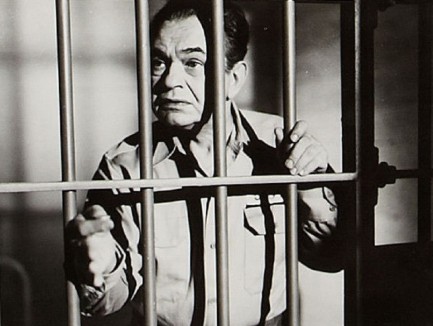
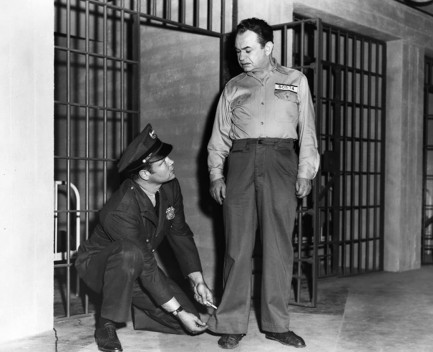
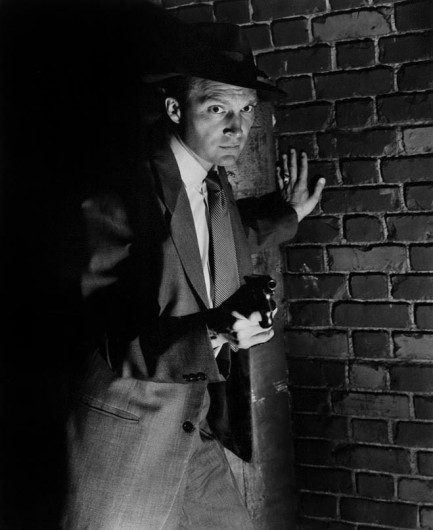
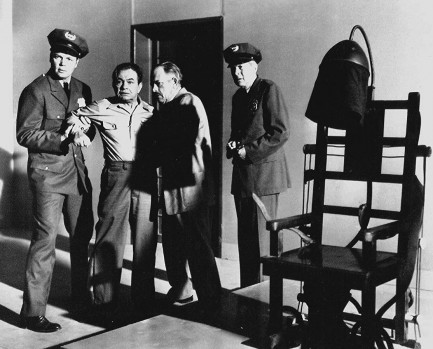
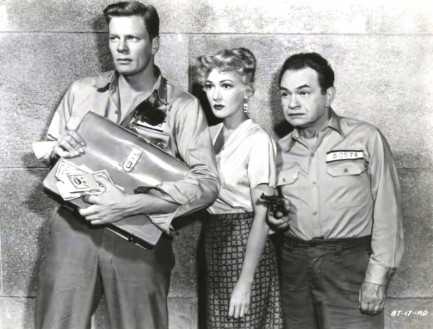
| Hollywoodland | May 22 2021 |

It's shocking how many Hollywood stars did smack.
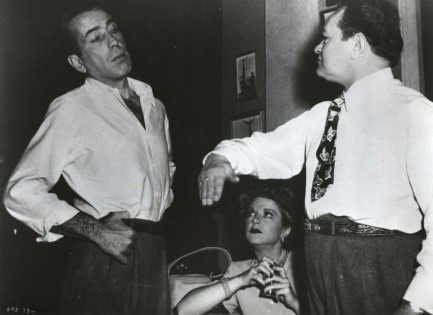
Everybody wants to slap somebody sometime. Luckily, actors in movies do it so you don't have to. The above shot is a good example. Edward G. Robinson lets Humphrey Bogart have it in 1948's Key Largo, as Claire Trevor looks on. In vintage cinema, people were constantly slapping. Men slapped men, men slapped women, women slapped women, and women slapped men. The recipient was usually the protagonist because—though some readers may not realize this—even during the ’40s and 50s, slapping was considered uncouth at a minimum, and downright villainous at worst, particularly when men did it. So generally, bad guys did the slapping, with some exceptions. Glenn Ford slaps Rita Hayworth in Gilda, for example, out of humiliation. Still wrong, but he wasn't the film's villain is our point. Humphrey Bogart lightly slaps Martha Vickers in The Big Sleep to bring her out of a drug stupor. He's like a doctor. Sort of.
In any case, most cinematic slapping is fake, and when it wasn't it was done with the consent of the participants (No, really slap me! It'll look more realistic.). There are some famous examples of chipped teeth and bloody noses deriving from the pursuit of realism. We can envision a museum exhibit of photos like these, followed by a lot of conversation around film, social mores, masculinity, and their intersection. We can also envison a conversation around the difference between fantasy and reality. There are some who believe portryals of bad things endorse the same. But movies succeed largely by thrilling, shocking, and scaring audiences, which requires portraying thrilling, shocking, and frightening moments. If actors can't do that, then ultimately movies must become as banal as everyday llife. Enjoy the slapfest.
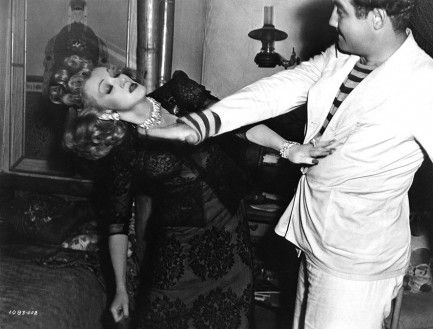 Broderick Crawford slaps Marlene Dietrich in the 1940's Seven Sinners.
Broderick Crawford slaps Marlene Dietrich in the 1940's Seven Sinners.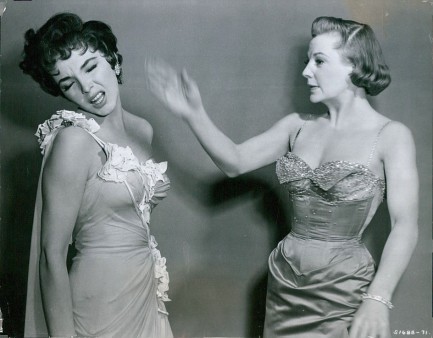 June Allyson lets Joan Collins have it across the kisser in a promo image for The Opposite Sex, 1956.
June Allyson lets Joan Collins have it across the kisser in a promo image for The Opposite Sex, 1956.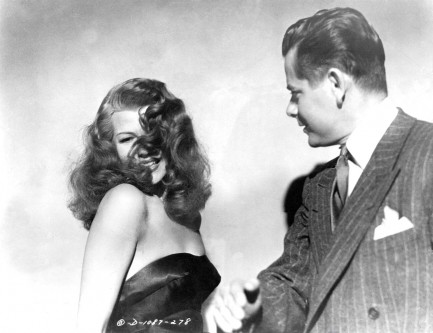 Speaking of Gilda, here's one of Glenn Ford and Rita Hayworth re-enacting the slap heard round the world. Hayworth gets to slap Ford too, and according to some accounts she loosened two of his teeth. We don't know if that's true, but if you watch the sequence it is indeed quite a blow. 100% real. We looked for a photo of it but had no luck.
Speaking of Gilda, here's one of Glenn Ford and Rita Hayworth re-enacting the slap heard round the world. Hayworth gets to slap Ford too, and according to some accounts she loosened two of his teeth. We don't know if that's true, but if you watch the sequence it is indeed quite a blow. 100% real. We looked for a photo of it but had no luck.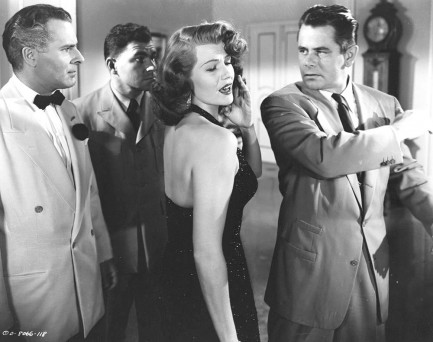 Don't mess with box office success. Ford and Hayworth did it again in 1952's Affair in Trinidad.
Don't mess with box office success. Ford and Hayworth did it again in 1952's Affair in Trinidad.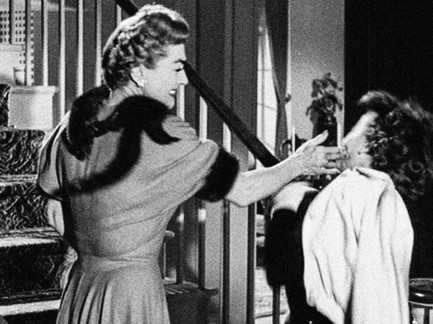 All-time film diva Joan Crawford gets in a good shot on Lucy Marlow in 1955's Queen Bee.
All-time film diva Joan Crawford gets in a good shot on Lucy Marlow in 1955's Queen Bee.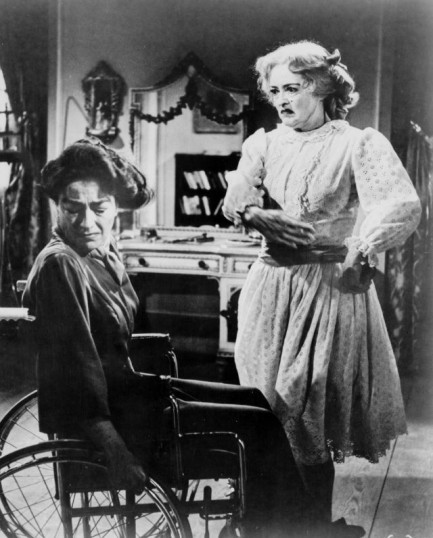 The answer to the forthcoming question is: She turned into a human monster, that's what. Joan Crawford is now on the receiving end, with Bette Davis issuing the slap in Whatever Happened to Baby Jane? Later Davis kicks Crawford, so the slap is just a warm-up.
The answer to the forthcoming question is: She turned into a human monster, that's what. Joan Crawford is now on the receiving end, with Bette Davis issuing the slap in Whatever Happened to Baby Jane? Later Davis kicks Crawford, so the slap is just a warm-up.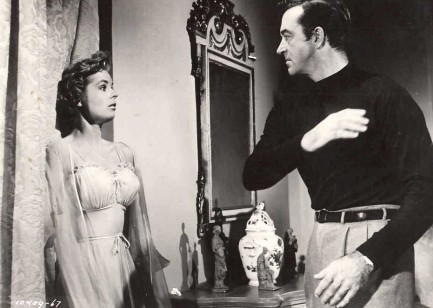 Mary Murphy awaits the inevitable from John Payne in 1955's Hell's Island.
Mary Murphy awaits the inevitable from John Payne in 1955's Hell's Island.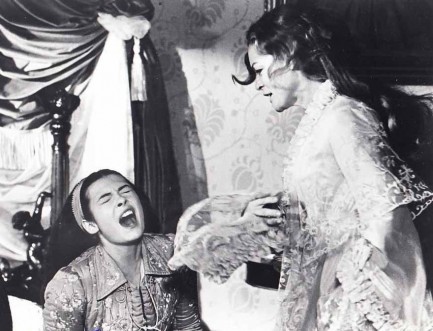 Romy Schneider slaps Sonia Petrova in 1972's Ludwig.
Romy Schneider slaps Sonia Petrova in 1972's Ludwig.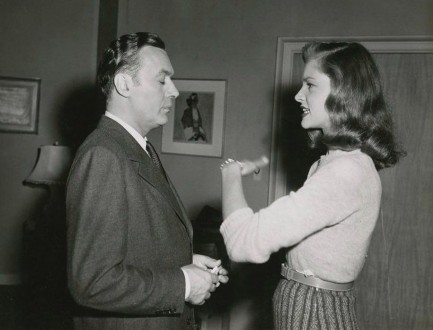 Lauren Bacall lays into Charles Boyer in 1945's Confidential Agent and garnishes the slap with a brilliant snarl.
Lauren Bacall lays into Charles Boyer in 1945's Confidential Agent and garnishes the slap with a brilliant snarl.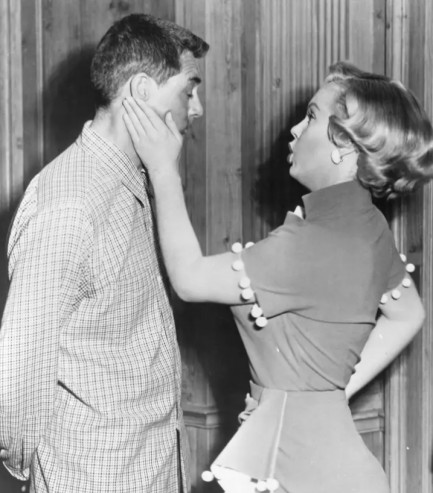 Iconic bombshell Marilyn Monroe drops a smart bomb on Cary Grant in the 1952 comedy Monkey Business.
Iconic bombshell Marilyn Monroe drops a smart bomb on Cary Grant in the 1952 comedy Monkey Business.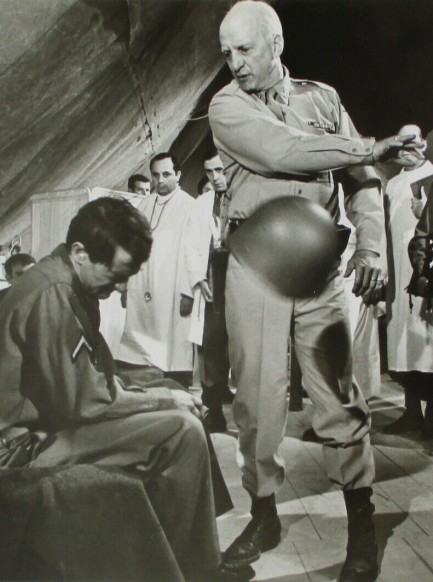 This is the most brutal slap of the bunch, we think, from 1969's Patton, as George C. Scott de-helmets an unfortunate soldier played by Tim Considine.
This is the most brutal slap of the bunch, we think, from 1969's Patton, as George C. Scott de-helmets an unfortunate soldier played by Tim Considine.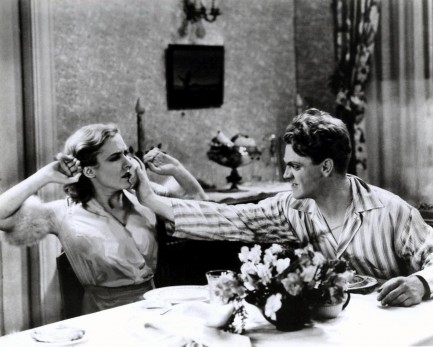 A legendary scene in filmdom is when James Cagney shoves a grapefruit in Mae Clark's face in The Public Enemy. Is it a slap? He does it pretty damn hard, so we think it's close enough. They re-enact that moment here in a promo photo made in 1931.
A legendary scene in filmdom is when James Cagney shoves a grapefruit in Mae Clark's face in The Public Enemy. Is it a slap? He does it pretty damn hard, so we think it's close enough. They re-enact that moment here in a promo photo made in 1931.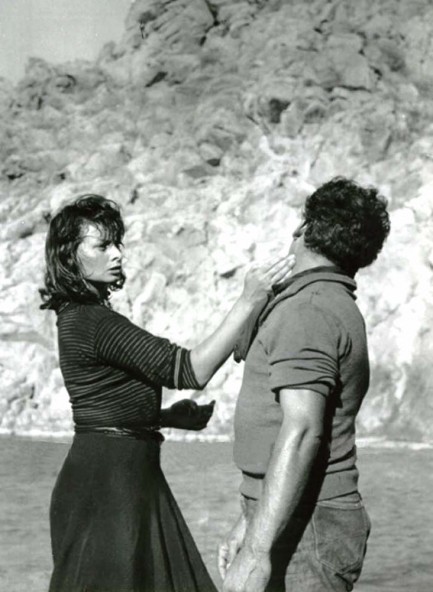 Sophia Loren gives Jorge Mistral a scenic seaside slap in 1957's Boy on a Dolphin.
Sophia Loren gives Jorge Mistral a scenic seaside slap in 1957's Boy on a Dolphin.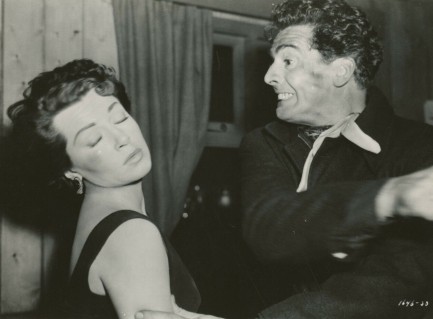 Victor Mature fails to live up to his last name as he slaps Lana Turner in 1954's Betrayed.
Victor Mature fails to live up to his last name as he slaps Lana Turner in 1954's Betrayed.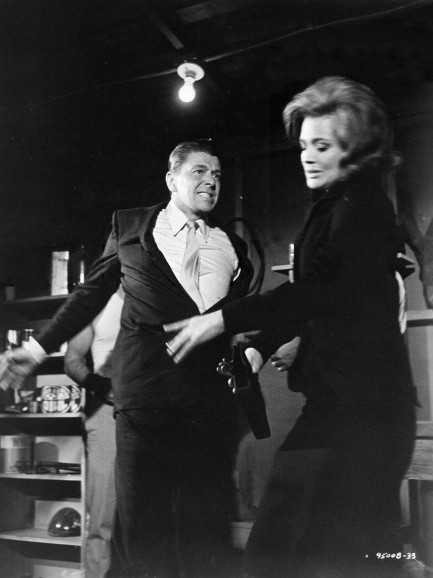 Ronald Reagan teaches Angie Dickinson how supply side economics work in 1964's The Killers.
Ronald Reagan teaches Angie Dickinson how supply side economics work in 1964's The Killers.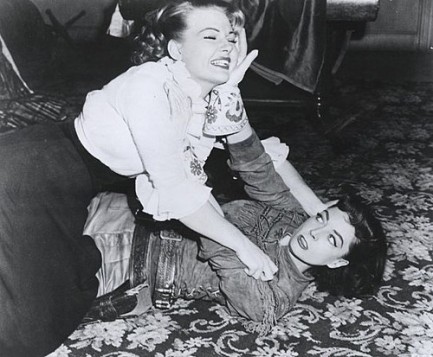 Marie Windsor gets in one against Mary Castle from the guard position in an episode of television's Stories of the Century in 1954. Windsor eventually won this bout with a rear naked choke.
Marie Windsor gets in one against Mary Castle from the guard position in an episode of television's Stories of the Century in 1954. Windsor eventually won this bout with a rear naked choke. It's better to give than receive, but sadly it's Bette Davis's turn, as she takes one from Dennis Morgan in In This Our Life, 1942.
It's better to give than receive, but sadly it's Bette Davis's turn, as she takes one from Dennis Morgan in In This Our Life, 1942.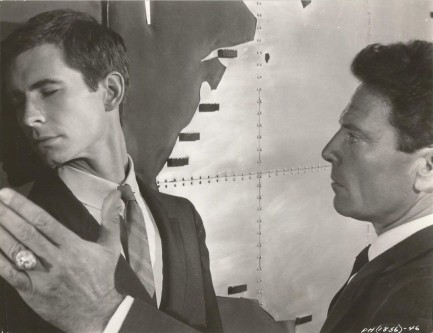 Anthony Perkins and Raf Vallone dance the dance in 1962's Phaedra, with Vallone taking the lead.
Anthony Perkins and Raf Vallone dance the dance in 1962's Phaedra, with Vallone taking the lead.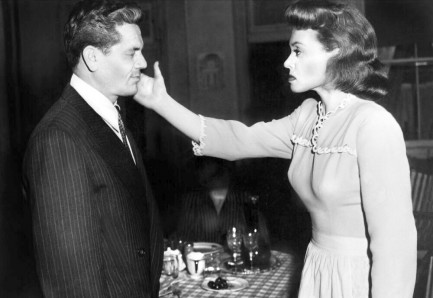 And he thought being inside the ring was hard. Lilli Palmer nails John Garfield with a roundhouse right in the 1947 boxing classic Body and Soul.
And he thought being inside the ring was hard. Lilli Palmer nails John Garfield with a roundhouse right in the 1947 boxing classic Body and Soul.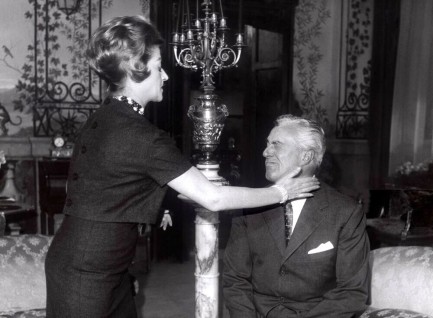 1960's Il vigile, aka The Mayor, sees Vittorio De Sica rebuked by a member of the electorate Lia Zoppelli. She's more than a voter in this—she's also his wife, so you can be sure he deserved it.
1960's Il vigile, aka The Mayor, sees Vittorio De Sica rebuked by a member of the electorate Lia Zoppelli. She's more than a voter in this—she's also his wife, so you can be sure he deserved it. Brigitte Bardot delivers a not-so-private slap to Dirk Sanders in 1962's Vie privée, aka A Very Private Affair.
Brigitte Bardot delivers a not-so-private slap to Dirk Sanders in 1962's Vie privée, aka A Very Private Affair.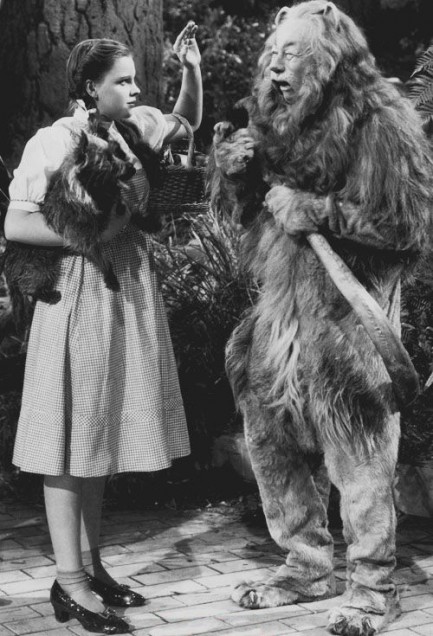 In a classic case of animal abuse. Judy Garland gives cowardly lion Bert Lahr a slap on the nose in The Wizard of Oz. Is it his fault he's a pussy? Accept him as he is, Judy.
In a classic case of animal abuse. Judy Garland gives cowardly lion Bert Lahr a slap on the nose in The Wizard of Oz. Is it his fault he's a pussy? Accept him as he is, Judy.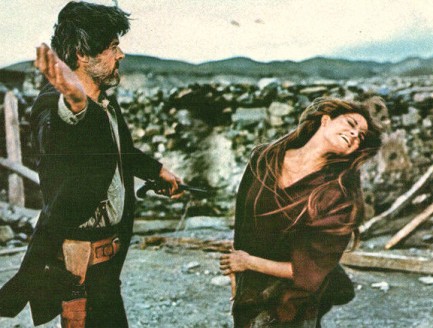 Robert Culp backhands Raquel Welch in 1971's Hannie Caudler.
Robert Culp backhands Raquel Welch in 1971's Hannie Caudler.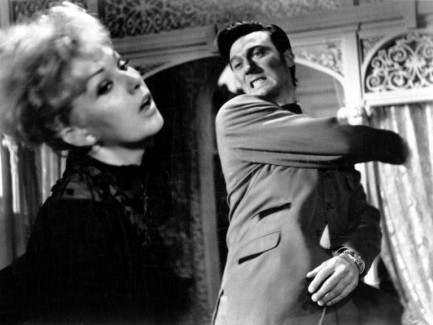 And finally, Laurence Harvey dares to lay hands on the perfect Kim Novak in Of Human Bondage.
And finally, Laurence Harvey dares to lay hands on the perfect Kim Novak in Of Human Bondage. Key LargoSeven SinnersThe Opposite SexGildaThe KillersWhatever Happened to Baby Jane?LudwigConfidential AgentPattonThe Public EnemyBoy on a DolphinOf Human BondageQueen BeeBetrayedStories of the CenturyIn This Our LifePhaedraBody and SoulIl vigileThe MayorThe Wizard of OzHannie CaulderVie privéeA Very Private AffairEdward G. RobinsonHumphrey BogartClaire TrevorMarlene DietrichBroderick CrawfordJune AllysonJoan CollinsGlenn FordRita HayworthBette FordJoan CrawfordMary MurphyJohn PayneRomy SchneiderSonia PetrovaLauren BacallCharles BoyerMarilyn MonroeCary GrantGeorge C. ScottTim ConsidineJames CagneyMae ClarkeSophia LorenJorge MistralJoan CrawfordLucy MarlowVictor MatureLana TurnerMarie WindsorMary CastleDennis MorganRaf ValloneAnthony PerkinsLilli PalmerJohn GarfieldLia ZoppelliKim NovakLaurence HarveyVittorio De SicaDirk SandersBrigitte BardotJudy GarlandBert LahrRaquel WelchRobert CulpRonald ReaganAngie Dickinson
| Vintage Pulp | May 10 2021 |

Welch proves indispensable to yet another ’60s caper flick.
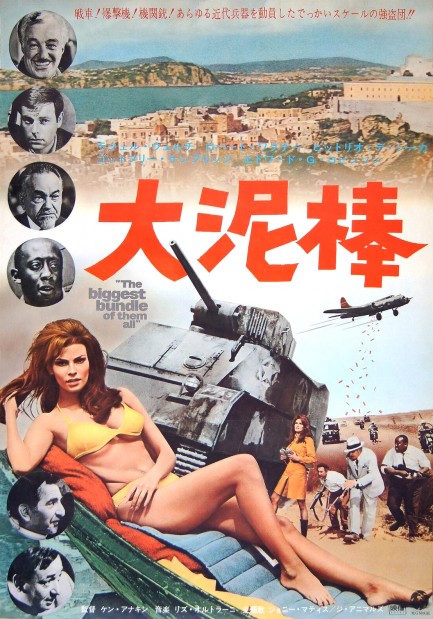
Above you see a promo poster for 大泥棒, or “Great Thief,” made for the 1968 Raquel Welch/Robert Wagner caper flick The Biggest Bundle of Them All. The U.S. poster was painted by master illustrator Robert McGinnis, but we decided to show you the Japanese art instead because it's rare. There are two more Japanese promos below that are also rare. We'll get to the McGinnis version later. In the film, Wagner and his henchmen kidnap an elderly Italian gangster played by Vittorio De Sica and hold him for ransom. Problem is he has no money. At first they don't believe him, but when it finally becomes clear he's broke, Wagner and Co. try to cut bait. But De Sica is terrified all Italy will find out he couldn't pay his own ransom. His reputation would be ruined. So he convinces his kidnappers to join him in a swindle that will maintain his reputation, make him rich again, and earn the kidnappers more money than they ever imagined. De Sica becomes the boss of his own abductors.
For a crime-comedy, it's an ingenious premise, which makes it a shame it wasn't original. Another movie with an almost identical plot called The Happening was in production at Columbia, and when the studio got wind of The Biggest Bundle of Them All it threatened to sue. Metro-Goldwyn-Mayer agreed to give Columbia a cut of Bundle's profits and a legal bloodbath was avoided, but in the same way De Sica's big caper doesn't exactly play out perfectly, Bundle's profits didn't blow the roof off MGM headquarters as planned. And no wonder. It wasn't just the script that wasn't original—the film falls into the same category as continental crime capers like Charade, To Catch a Thief, and Topkapi, and those make for crowded and treacherous cinematic waters. Bundle isn't sophisticated enough, or exciting enough, or infused with enough sexual chemistry to compete with better films of its ilk.
Speaking of sexual chemistry, Welch is naturally the big attraction of any movie she's in, and we've seen enough of her work now to understand that she was more of a persona than an actress during this mid- to late-’60s period. In film after film she basically played herself. Here she smiles and quips and poses, and it's all very Welchian in that groovy way her fans had come to expect—bikinis, lingerie, go-go dancing and all. The movie would be worth far less without her. There are also supporting appearances by Edward G. Robinson and Femi Benussi, while future blaxploitation icon Godfrey Cambridge is one of the kidnappers, so there's plenty for stargazers to enjoy here, but we can't call the movie a success. If you have nothing to do some evening, it might give you a few smiles, but not a bundle of them. After premiering in the U.S. in 1968, The Biggest Bundle of Them All opened in Japan today in 1968.

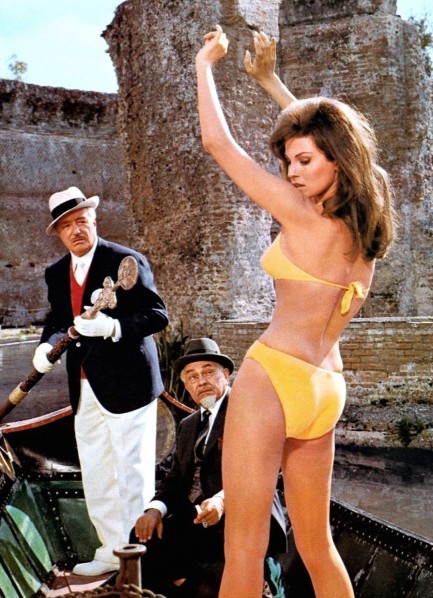
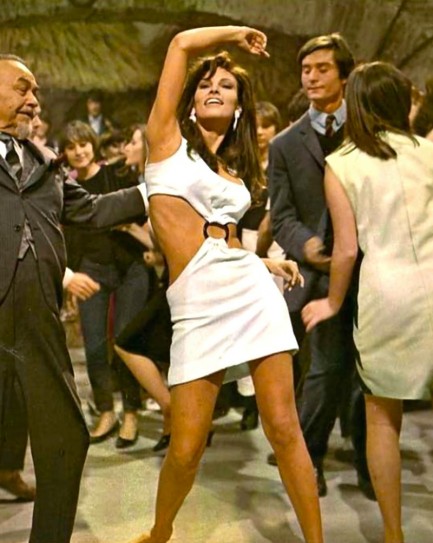
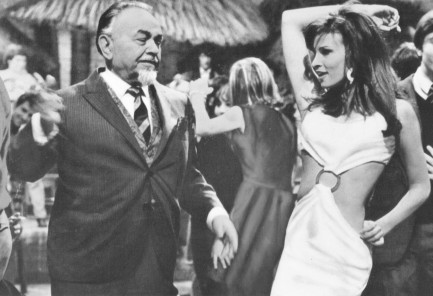
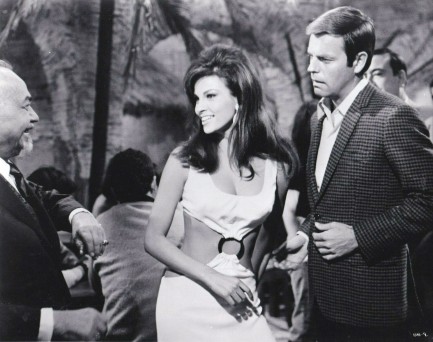
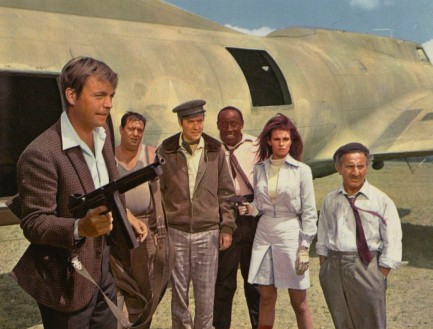
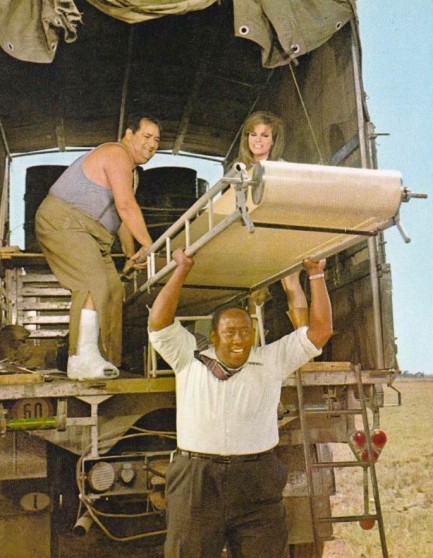
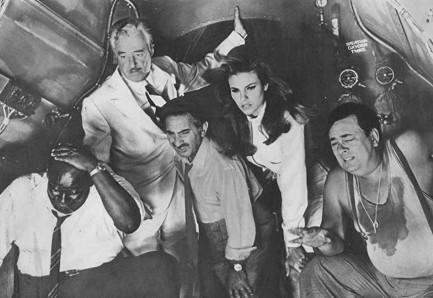
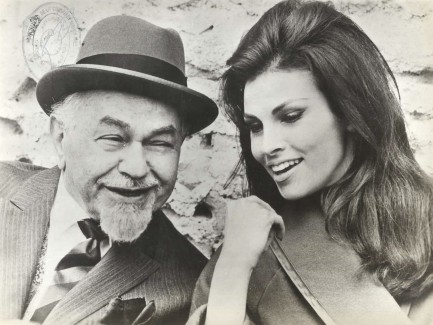
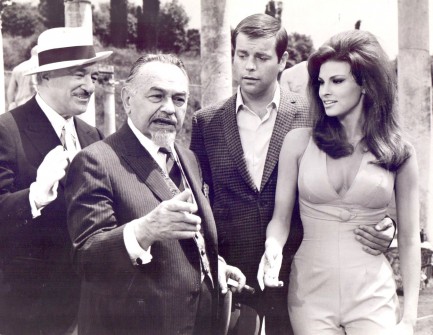
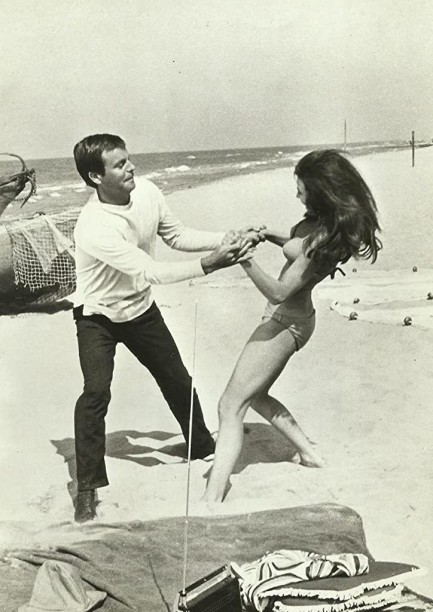
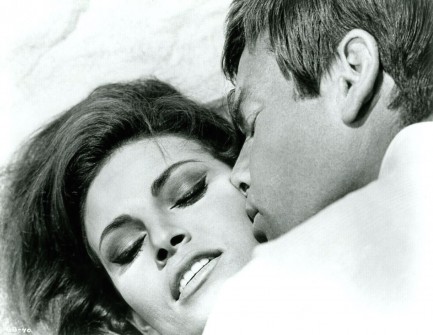
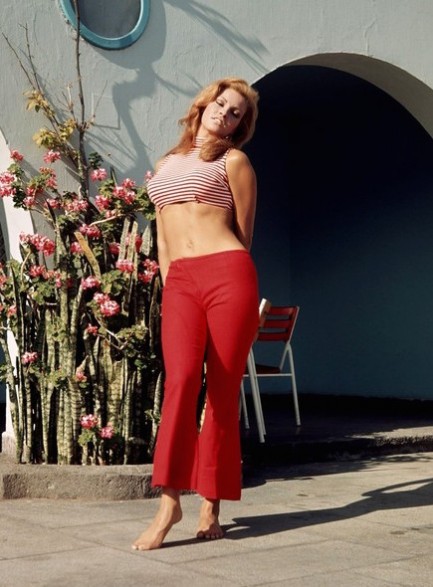

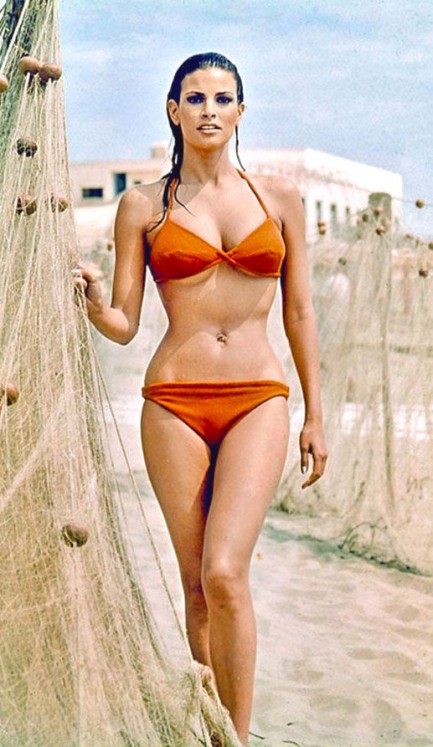
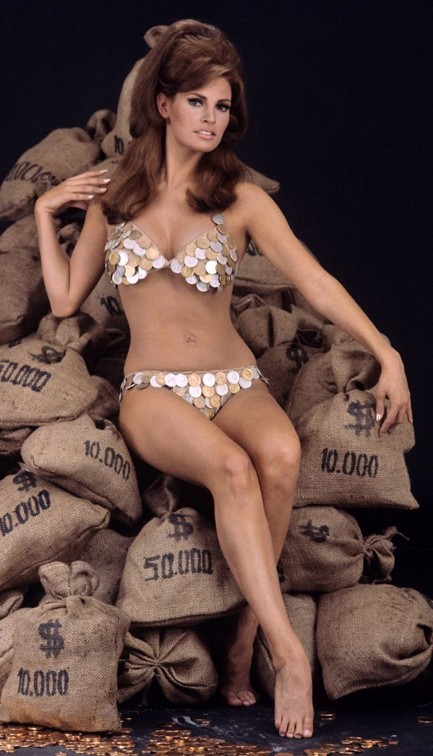

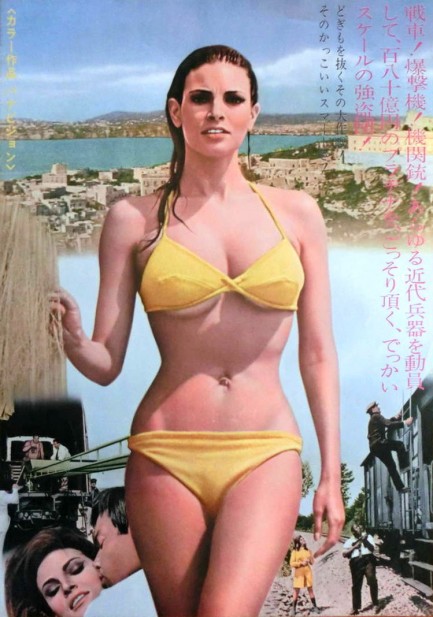


















| Vintage Pulp | Mar 16 2021 |

It's just the wind. Or possibly the screaming of damned souls in torment. But more likely the wind.
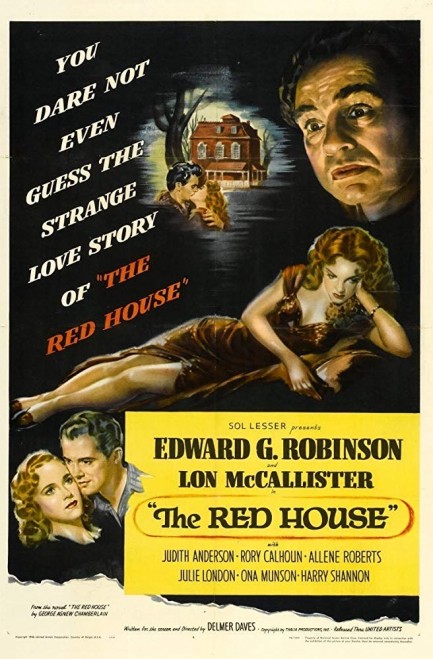
“You dare not even guess the strange story of The Red House,” this promo poster tells us about Edward G. Robinson's 1947 psychological suspense drama, but we dared, and we didn't have any trouble guessing correctly. What you get here is a mystery with a suggestion of the supernatural—always a draw for us. Some sites call this a horror movie. We're okay with that too. Horror, psychological suspense, and mystery walk hand in hand—in this case through the creepy night. Working from a screenplay adapted from George Agnew Chamberlain's 1945 novel, Robinson plays a man living in idyllic simplicity on a farm with his sister and adopted daughter. He hires a helper, a decision that goes awry when the new help develops an interest in the nearby cursed woods, in which there's supposedly a haunted red house, disembodied screaming voices (or maybe just the wind), and other dangers sane people would avoid.
But this new farmhand is filled with the arrogance of youth, isn't superstitious, and resolves to solve the mystery, a decision that threatens to tear Robinson's makeshift family apart and unearth terrors from the past. Edward the G. isn't at his very best working with what is a tricky script, but he gets useful support from young co-stars Lon McCallister, Rory Calhoun, Allene Roberts, and Julie London. Roberts in particular has a crucial role, and in her first film, and aged only nineteen, she manages to keep her head above water—barely. While The Red House isn't top notch, it's enjoyable enough, and if you appreciate vintage creepfests it might give you a chill or two. So what's in the woods? We can't tell you, but you can be sure there's something—and it ain't good. The Red House premiered today in 1947.
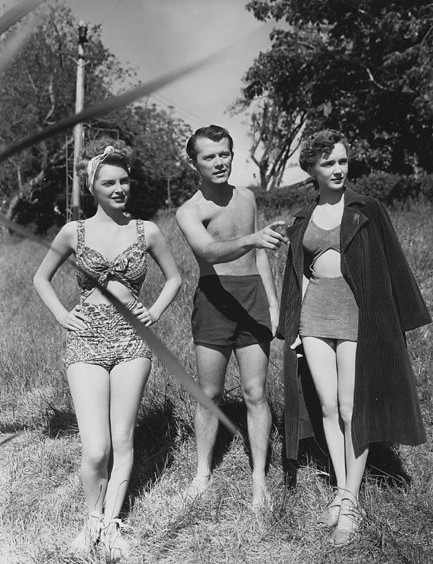
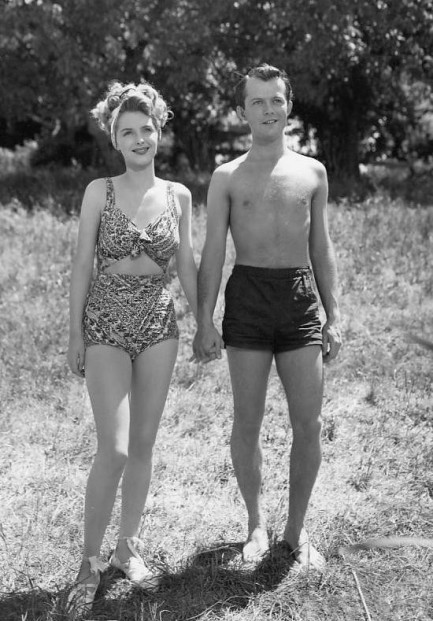

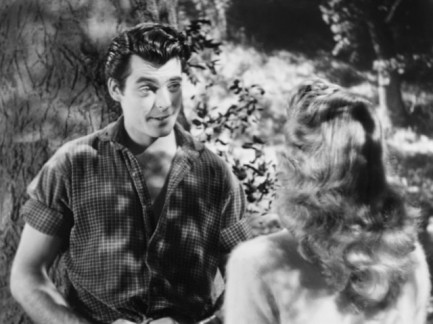
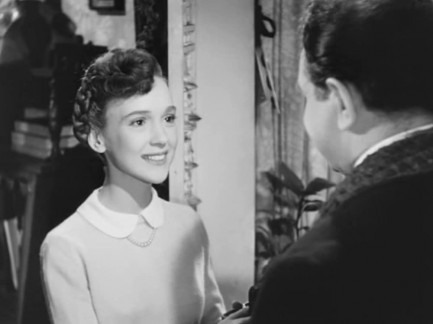
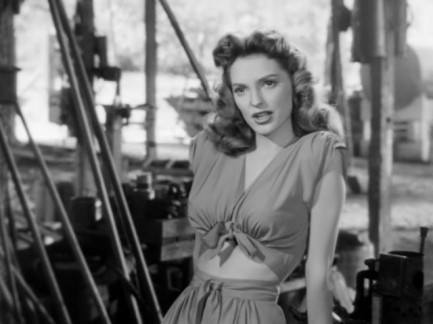
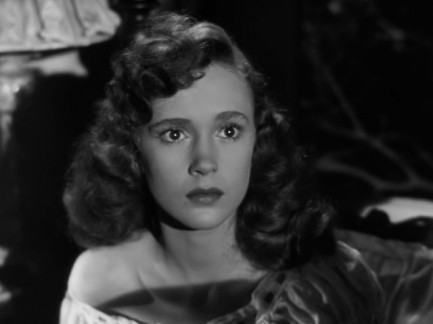
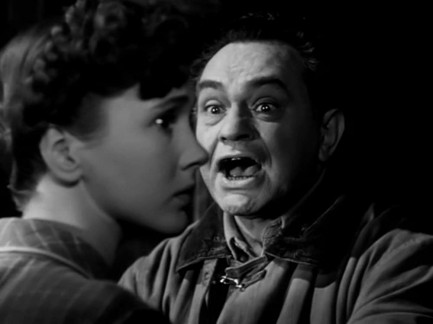
| Vintage Pulp | Jul 31 2020 |

Humphrey is pitch perfect as always but it's Edward who makes this movie sing.
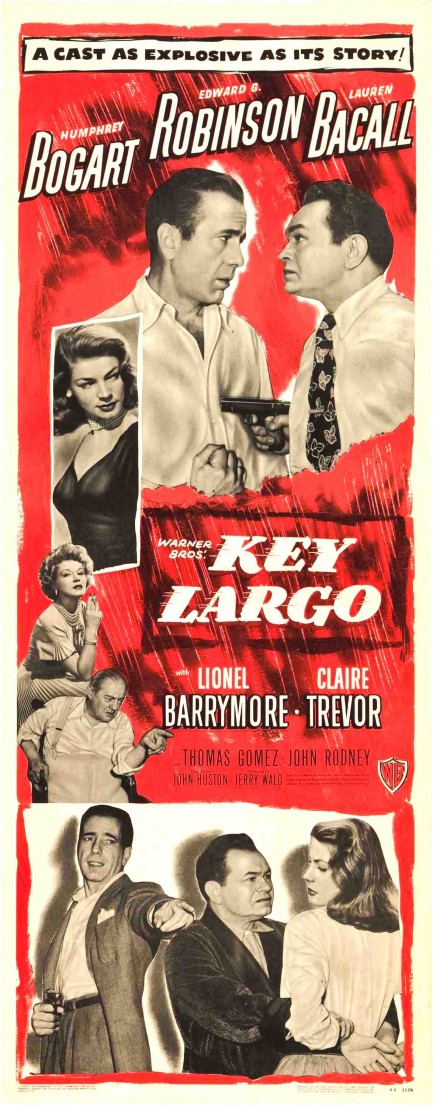
Above, one of many promo posters for the classic drama Key Largo. This movie, as you doubtless know, is great. It hinges on Edward G. Robinson's bravura performance as a washed up gangster trying to make a comeback, but he gets ample onscreen help from co-stars Humphrey Bogart, Lauren Bacall, Lionel Barrymore, Thomas Gomez, Claire Trevor, Dan Seymour, and others. And John Huston in the director's chair is no slouch bringing the foreground drama and hurricane background to life. Key Largo is often called a film noir. Is it though? Hmm... Bogart certainly fits the bill in terms of characterization, but since the movie lacks most other noir elements we're inclined to call it a straight crime drama. But that's just our opinion. It was first seen by the public at a Hollywood preview in mid-July 1948, and went into full national release today.
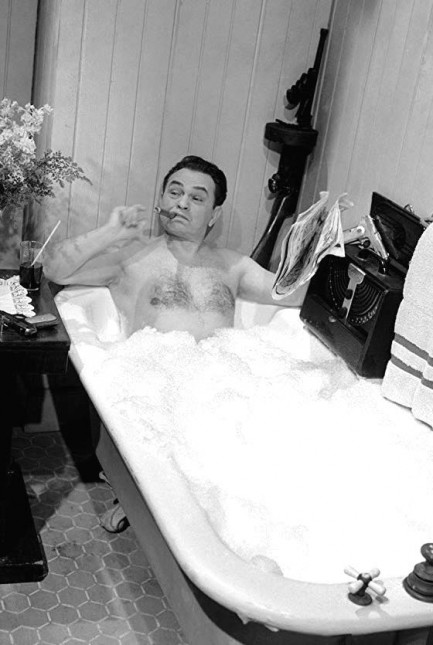
| Femmes Fatales | May 15 2020 |

Deliveries go in the rear. And get your mind out of the gutter.
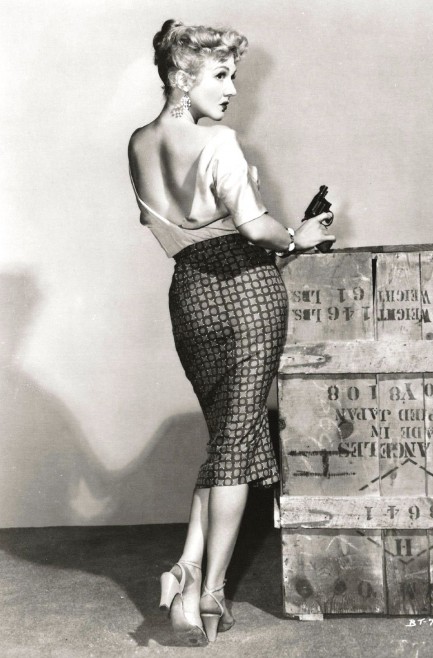
American actress Jean Parker, who enjoyed a long film career that ran from 1932 to 1965 and comprised more than seventy screen appearances, watches over some crates in this promo photo made for the 1954 crime drama Black Tuesday, in which she co-starred with Edward G. Robinson. Must be something very valuable in those boxes for her to be armed and ready to ventilate somebody. Is toilet paper still the valuable currency of the moment? It's never been scarce where we live but we heard people in other places were ready to kill for it a few weeks ago. We'd prefer if the cargo here were good booze, possibly Bulleit bourbon. Well, let's flip them upside down and...
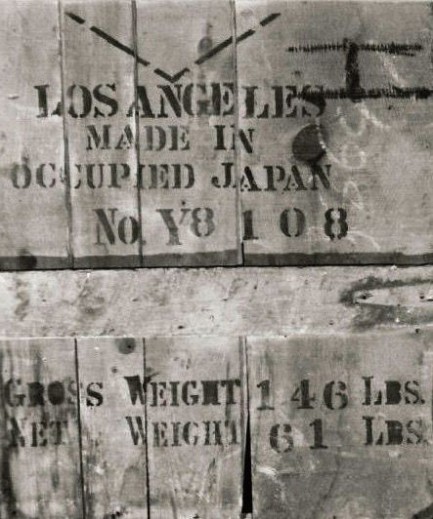 Aha. So, they're items made in occupied Japan. We embarked upon the digital superhighway, conjured up several synopses for Black Tuesday, and using search-find on keyword “Japan,” so we wouldn't spoil the plot by actually reading any details, got no hits. Probably the crates are just props that had been sitting around RKO-Pathé Studios, where the movie was shot. But we can't be sure. It's just these sorts of small mysteries that influence our movie queue. We'll screen this and report back.
Aha. So, they're items made in occupied Japan. We embarked upon the digital superhighway, conjured up several synopses for Black Tuesday, and using search-find on keyword “Japan,” so we wouldn't spoil the plot by actually reading any details, got no hits. Probably the crates are just props that had been sitting around RKO-Pathé Studios, where the movie was shot. But we can't be sure. It's just these sorts of small mysteries that influence our movie queue. We'll screen this and report back.































